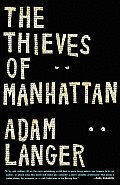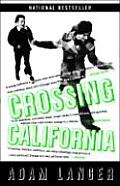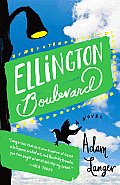
I've never been very talented at solving crosswords. When Friday rolls around, I feel lucky if I can do half the
New York Times puzzle. And, though I'm pretty good at doing the Jumble, when it comes to diagramless puzzles and the Sunday acrostic, I'm pretty much hopeless. As for KenKen and Sudoku, I can't begin to motivate myself — too many numbers; not enough words.
On the other hand, I've always been a fan of puzzles in books, and I don't necessarily mean whodunits; I mean those books that actually have clues, puzzles, and word games embedded within them. From Donald Sobol's Encyclopedia Brown stories and Two-Minute Mysteries to Alain Robbe-Grillet's Recollections of the Golden Triangle, I have long been a fan of mysterious books that come with solutions at the end. Literary tales may have accounted for some of my favorite early reading, but when I was 12, I read Kit Williams's 1979 Masquerade more than any other book in my collection, hoping to decipher the author's clues to discover where Williams had buried a valuable, bejeweled bunny. No, I never did figure out that the bunny in Williams's book was buried "close by Ampthill."
Let me admit here that I would be lying if I said I read my father's copies of Esquire for the short stories; I read them for the Canadian Club ads, hoping to figure out where a case of that whiskey was buried. The Beatles were among my heroes when I was growing up and, yes, I was one of those people who played their records backwards to hear "Turn me on, dead man" and "I buried Paul." I even listened to the "secret message" that you could hear when you played the opening of the ELO album Secret Messages backwards. It wasn't very impressive; as I recall, it was "Welcome to the show."
Alex Garland used an acrostic to offer a secret message in his book The Coma and last year, even Governor Schwarzenegger used the first letter of each paragraph he wrote to create an insulting message to the California State Assembly. And when I was writing my novel The Thieves of Manhattan, which is filled with its own literary jargon and tells the twisting, turning story of Ian Minot, a down-on-his-luck writer and barista who becomes embroiled in a con game in the publishing world involving an editor named Jed Roth, a hooligan librarian named Norbert Piels, and a foul-mouthed manuscript appraiser named Iola Jaffe, I decided to embed a few secret messages myself.
Just a few days ago, I was talking with Liane Hansen, host of the Sunday broadcast of Weekend Edition on NPR, and, for the first time, I revealed that I had inserted puzzles and clues into Thieves of Manhattan. Before that interview, I hadn't told anyone. Not even my editor. Nor my spouse.
 As it turns out, there are actually about five secret clues embedded in Thieves, none of which drastically change the story or a reader's understanding of it. But, if solved, they do provide a few additional layers of meaning.
As it turns out, there are actually about five secret clues embedded in Thieves, none of which drastically change the story or a reader's understanding of it. But, if solved, they do provide a few additional layers of meaning.
Firstly, there are two characters whose names are anagrams which, when solved, help to provide insight into their motivations. Next, there is a geographical clue that might give some additional insight into the background of the protagonist.
Finally, there are two literary clues, instances of either homage or theft (depending on your definition), referencing a classic work of literature and a modern bestselling work of literary fiction, which reveal additional layers of the protagonist Ian and his onetime girlfriend Anya Petrescu. A hint: The clues have nothing to do with James Frey or Margaret B. Jones or any of the other authors of disputed works that have scandalized the publishing community.
Experts on 1970s rock might argue that there is a sixth clue in my book that involves lyrics to the Kansas song "Point of Know Return," but a) that clue is fairly obvious; and b) it doesn't really provide any additional insight into the story.
I've begun telling a few more people about the clues in Thieves of Manhattan and have already struck up a very involved correspondence with a reader who agreed to allow me to refer to our emails in this essay as long as I didn't reveal her name and identified her as "Mystery Kit."
Some people might well think that I have invented Mystery Kit and, if I were reading this, I might think the same thing, but I can assure you that Mystery Kit exists. Or, someone calling him- or herself Mystery Kit exists. If I had invented her, I promise you that I would have chosen a far more convincing pseudonym.
Nevertheless, when Mystery Kit learned that there were anagrams in my book, she immediately started plugging names of characters into something she called her "Internet Anagram Server." I'd never heard of this before, but I have no reason to doubt her.
The Internet Anagram Server provided Kit with these suggestions. I'll quote directly from one of her messages: "I would have thought Jed Roth or Geoff Olden would be anagrams, but they're not.... I'm guessing you nicknamed Jed after the title of the Herman Melville story, The Confidence-Man: His Masquerade." Sorry Kit, I didn't.
And then Kit tried putting the name Blade Markham, a swaggering, perhaps fraudulent memoirist in my novel, into the Anagram Server. No luck: "Blade Markham = 'blame dark ham,'" Kit wrote.
 Nope. Can't say that I had that in mind either. Sorry.
Nope. Can't say that I had that in mind either. Sorry.
And then Kit tried the name of my Romanian short story writer Anya Petrescu and came up with "sanctuary pee" and "a panty rescue." And "pancreas tune." She also points out that Anna Petrescu is a Romanian-born character in False Impression by Jeffrey Archer.
Nope again, Kit. I didn't have "pancreas tune" in mind, nor have I ever read any Jeffrey Archer.
And finally, Kit wrote, "The characters Iola Jaffe, Jens von Bretzel, Miri Lippman, and Rowell Templen all looked promising, but I could find nothing worthwhile."
Giving up, Kit asked if Ian Minot's short story collection, called Myself When I Am Real, was intended as an anagram for "A lame whiner myself." A good one, I thought, but unfortunately, I hadn't intended that one either.
Readers, it's now up to you. If you feel like playing after you've finished reading The Thieves of Manhattan, I'll repeat the five clues embedded in the book. Two are oblique literary references (one to a classic work, one to a modern literary hit), two are anagrams, and one is geographical. I can't promise you a bejeweled bunny or a case of Canadian Club if you get any of them, but I will tell you if you're right, I'll sign your copy of Thieves (if you'd like), and maybe send some other special prize if I can find one lying around here.
And then again, maybe you could just read the book without bothering with my puzzles. I think you can enjoy it just as well without them.
May I say in closing that I have used an acrostic to write this essay; if you assemble the first letter of each paragraph, you'll get a clue. I apologize that it's not a very good one, but I'd rather not give too much away; as a reader, I always prefer to solve puzzles myself.